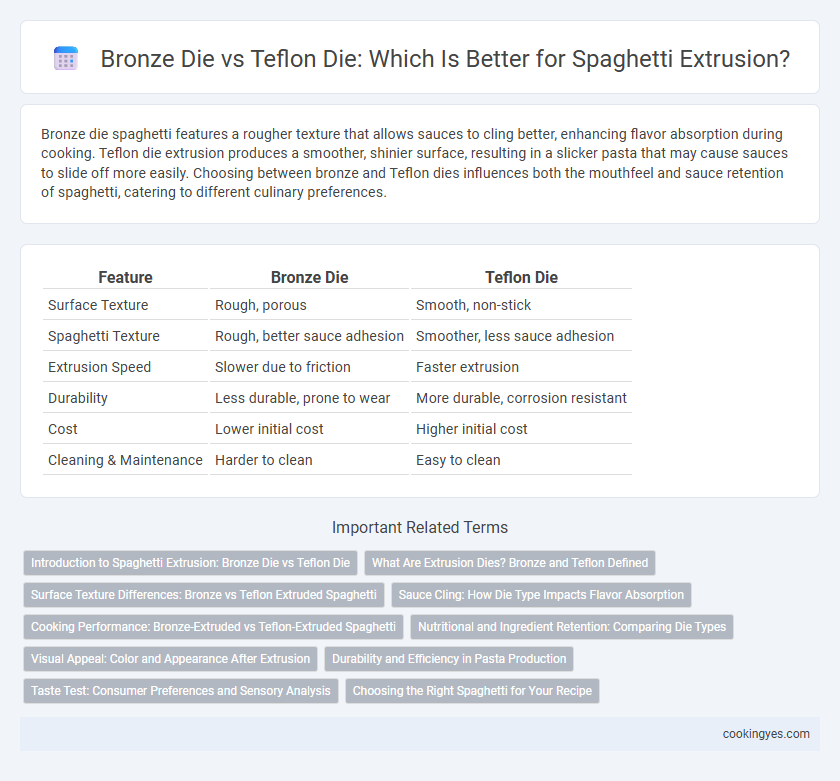Bronze die spaghetti features a rougher texture that allows sauces to cling better, enhancing flavor absorption during cooking. Teflon die extrusion produces a smoother, shinier surface, resulting in a slicker pasta that may cause sauces to slide off more easily. Choosing between bronze and Teflon dies influences both the mouthfeel and sauce retention of spaghetti, catering to different culinary preferences.
Table of Comparison
| Feature | Bronze Die | Teflon Die |
|---|---|---|
| Surface Texture | Rough, porous | Smooth, non-stick |
| Spaghetti Texture | Rough, better sauce adhesion | Smoother, less sauce adhesion |
| Extrusion Speed | Slower due to friction | Faster extrusion |
| Durability | Less durable, prone to wear | More durable, corrosion resistant |
| Cost | Lower initial cost | Higher initial cost |
| Cleaning & Maintenance | Harder to clean | Easy to clean |
Introduction to Spaghetti Extrusion: Bronze Die vs Teflon Die
Spaghetti extrusion utilizes dies crafted from bronze or Teflon, each influencing the pasta's texture and surface quality. Bronze dies create a rougher surface that helps sauce adhesion and a traditional artisanal appearance, while Teflon dies produce a smoother, glossier finish often preferred for mass production due to easier release and less stickiness. The choice between bronze and Teflon dies significantly impacts the final spaghetti's cooking performance and consumer appeal in both industrial and artisanal pasta making.
What Are Extrusion Dies? Bronze and Teflon Defined
Extrusion dies are specialized tools used in pasta production to shape dough as it is forced through openings, determining the spaghetti's texture and surface finish. Bronze dies, made from rough-textured bronze alloy, produce spaghetti with a coarser surface that holds sauce better and offers a traditional, artisanal texture. Teflon dies, coated with non-stick polytetrafluoroethylene, create smoother, shinier spaghetti strands that cook evenly but may not retain sauce as effectively as bronze die pasta.
Surface Texture Differences: Bronze vs Teflon Extruded Spaghetti
Spaghetti extruded through bronze dies features a rougher, more porous surface that enhances sauce adhesion and flavor absorption due to its textured finish. In contrast, Teflon die extrusion produces a smooth, glossy surface that reduces sauce clinging but offers a sleek, uniform appearance. The surface texture differences directly impact cooking performance and culinary experience, with bronze dies preferred for traditional, authentic pasta dishes.
Sauce Cling: How Die Type Impacts Flavor Absorption
Bronze die spaghetti features a rougher surface that enhances sauce cling, allowing the pasta to absorb flavors more effectively. Teflon die spaghetti produces a smoother texture, which often results in less sauce adhesion and a milder taste experience. Choosing bronze die extrusion improves the overall flavor profile by maximizing sauce retention on each strand.
Cooking Performance: Bronze-Extruded vs Teflon-Extruded Spaghetti
Bronze-extruded spaghetti features a rougher surface texture that enhances sauce adherence, resulting in a more flavorful and enjoyable eating experience, whereas Teflon-extruded spaghetti produces a smoother surface that may cause sauces to slide off. The porous nature of bronze dies also fosters optimal water absorption during cooking, reducing stickiness and maintaining firmness. Teflon dies, while offering faster extrusion and higher production efficiency, often yield pasta with less ideal cooking performance due to their slick surface finish.
Nutritional and Ingredient Retention: Comparing Die Types
Bronze die extrusion creates a rougher surface on spaghetti, enhancing sauce adhesion while preserving more nutrients and natural flavors due to slower processing temperatures. Teflon die, with its smoother surface, often results in faster extrusion but may cause slight nutrient degradation from higher heat and friction. Nutrient retention in bronze die pasta supports a richer ingredient profile, making it preferable for quality-focused production.
Visual Appeal: Color and Appearance After Extrusion
Bronze dies create spaghetti with a rougher, more porous surface that better holds sauce and results in a rustic, artisanal appearance with a deep golden hue. Teflon dies produce a smoother, shinier pasta with a paler color and uniform texture, often perceived as less traditional but visually more polished. The choice between bronze and Teflon extrusion significantly influences spaghetti's final color intensity and surface texture, impacting consumer perception and cooking qualities.
Durability and Efficiency in Pasta Production
Bronze die extrusion creates rough-textured spaghetti, enhancing sauce adherence, but its lower durability leads to more frequent replacements, increasing downtime in pasta production. Teflon dies offer higher efficiency with smoother surfaces and longer lifespan, reducing maintenance needs while producing consistent pasta quality. Choosing between bronze and Teflon dies depends on balancing the desired pasta texture with production throughput and operational cost-effectiveness.
Taste Test: Consumer Preferences and Sensory Analysis
Bronze die extruded spaghetti features a rougher texture that enhances sauce adhesion, leading to higher consumer taste ratings and perceived authenticity in sensory tests. Teflon die spaghetti, with its smoother surface, often results in a cleaner appearance but scores lower in flavor intensity and mouthfeel during consumer preference evaluations. Sensory analysis reveals a significant preference for bronze die pasta due to its robust texture and enhanced taste profile.
Choosing the Right Spaghetti for Your Recipe
Choosing the right spaghetti for your recipe depends significantly on the extrusion process, with bronze die and Teflon die being the primary options. Bronze die spaghetti has a rougher texture that holds sauces better, making it ideal for hearty, thick sauces, while Teflon die spaghetti produces a smoother surface, suited for light, delicate sauces. Understanding these differences helps in selecting spaghetti that enhances the flavor and texture of your dish.
Bronze die vs Teflon die for spaghetti extrusion Infographic

 cookingyes.com
cookingyes.com